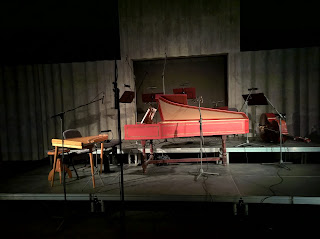 |
| Green life at Kultuurikatel, Tallinn |
We missed the Bird Song Disco (dancing to birdsong recordings made by Veljo Runnel) but we did catch one of the performances of The Great Clean Up. We gathered at mid-day in Freedom Square on Saturday 16 April 2015, where it was sunny and clear enough to sit outside with a coffee. A group of women appeared, all dressed in white and each with a broom or a pair of stones (they were students from the Estonian Dance Agency Dance Academy and a team of women composers).
For the next 10 minutes we witnessed a striking dance piece as the women cleaned-up the square, with choreography by United Dancers of ZUGA (Riina Ausma, Kärt Tönnison, Helen Reitsnik and Tiina Mölder) and music by Tatjana Kozlova-Johannes. There was no external sound-track, instead the co-ordinated sound of the brooms and the clicking of stones formed a meditative sound-track to the movement. This meditativeness was deliberate as the clean-up of the title referred not just to physical cleaning but to creating an interior sense of well-being too.
 |
| Flying babies and trolls at the Estonian Theatre and Music Museum |
We caught the closing event when surrounded by an installation of flying babies and trolls, we were able to meet some of the composers and participants, hear the compositions as well as some live mixing of the baby sounds (as well as eating some pretty fabulous cake). The composers participating took a varied approach to source material from using baby sounds exclusively to mixing them with other material.
Another theme which emerged during our visits to festival events was the remarkable (to us, the UK visitors) number of women taking part in the festival whether as organisers, conductors (such as Anu Tali who conducted the Estonian National Symphony Orchestra), composers or performers. That this seemed unremarkable to our Estonian friends and colleagues only made it more remarkable to us. The balance of genders in the festival participants seemed far more even than we ever experience in the UK.
At our final daytime event on Saturday we experienced this in action when all three harpsichord players happened to be women, again without any particular point being made. The Bellflower Family took place in the small hall of Kultuurikatel (Culture Caultron), itself an example of creative recycling. A former power-station now 100 years old, the redundant historical building has been turned into a cultural centre with three different performance spaces (though as yet no catering, but the helpful festival volunteer sent us over to the petrol station across the road where the coffee was very good indeed).
 |
| Harpsichord and Kannel at Kultuurikatel, Tallinn |
Mirjam Tally (born 1976) was content, in Swimming Bach, to submerge de-constructed Bach under water (via electronics). Perhaps the most imaginative piece was by Kristjan Körver (born 1976). His Psallite for Estonian kannel (a type of zither, played with the hands) and harpsichord. The two instruments had strikingly different sounds and harpsichordist Ene Nael and kannel player Kristi Mühling seemed to revel in the way Köver explored the differences in timbre between the two. I was particularly struck by Mühling's use of tuning hammers to create evocative glissandi.
Tönu Körvits (born 1969) Folia, played by Juia Ageyeva Hess, took the archetypical Folia as a ground over which to apply thoughtful variations though it lacked the mythic fantasy of his best work. Anti Marguste (1931-2016) wrote Cycle Campanulacae (The Bellflower Family) in 2009 yet the work as only just receiving its first performance, given by Julia Ageyeva Hess. Consisting of four short movements, the style was highly neo-classical with each movement in a distinct, characteristing style. Marguste's Para-Phrasein, a paraphrase for harpsichord and string-ensemble proved to be a lively neo-classical work, stylish but breaking no new ground. It was played by Imbi Tarum and the Corelli Consort, who also played the final work in the programme.
Concerto grande per clavicembalo e strumenti a corde was by Rein Rannap (born 1953), a composer whose work crosses the popular/classical divide and whom I understand to have played in a successful rock band. The concerto seemed to take the music of Michael Nyman as its inspiration, without the anarchic energy of that composer. Despite some bravura harpsichord playing by Imbi Tarum, the piece failed to make a great impression, though a crisper, sharper-edged performance might have helped.
Other Estonian Music Days events:
Spring in Tallinn - Anu Tali and the Estonian National Symphony Orchestra
Ancient and modern - new music for the varioola, Estonia's first electronic instrument
Elsewhere on this blog:
- Spring in Tallin: Anu Tali and the Estonian National Symphony Orchestra at the Estonian Music Days - concert review
- Precision and enthusiasm: The Gesualdo Six - concert review
- Ancient & modern in Tallinn: Introducing the varioola, Estonia's first electronic instrument - concert review
- Intelligent programming & fine singing: The Evening Hour, choir of Jesus College, Cambridge - CD review
- A story to tell: Johnny Herford & James Baillieu at the Wigmore Hall - concert review
- Whimsically gothic: Mahogany Opera Group in The Rattler - opera review
- Elegant Bach: Bach Collegium Japan in Mass in B Minor - concert review
- Not just charming background music: Handel at Vauxhall - CD review
- Blaze of youth indeed: Chad Hoopes, National Youth Orchestra of Great Britain and Kristjan Järvi - concert review
- Much to look forward to: Royal Opera's 2016-17 season preview
- Pulling focus: Katie Mitchell's new production of Donizetti's Lucia di Lammermoor - Opera review
- Stunning arias, telegraphic plot: Handel Arminio - CD review
- Home



%20and%20kids.jpg)
.webp)





.jpg)
No comments:
Post a Comment